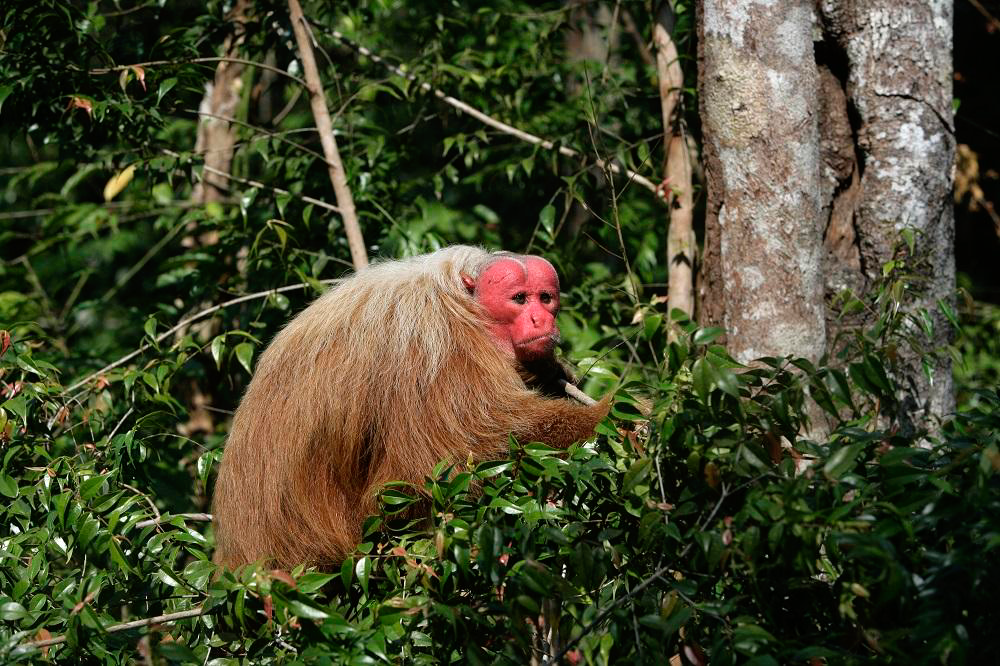Deep within the lush, untamed realms of the Amazon rainforest resides a creature of remarkable peculiarity and charm – the Northern Bald Uakari (Cacajao calvus rubicundus). This extraordinary primate, distinguished by its vivid red face, striking bald head, and haunting golden eyes, epitomizes the enigmatic biodiversity that thrives in the heart of South America. Despite its captivating appearance, the Northern Bald Uakari remains relatively obscure to many, yet its ecological significance and evolutionary adaptations paint a fascinating portrait of survival in one of the world’s most biodiverse ecosystems.
Taxonomy and Distribution
Belonging to the New World monkey family, the Northern Bald Uakari is a subspecies of the Bald Uakari (Cacajao calvus). Within the Amazon basin, it is endemic to specific regions of Brazil, Colombia, and Peru, primarily inhabiting flooded forests and riparian zones along major river systems such as the Amazon and its tributaries. Its range encompasses remote and pristine habitats where it has evolved to thrive in the unique ecological niches afforded by the flooded forests of the Amazon basin.
Physical Characteristics
The most striking feature of the Northern Bald Uakari is undoubtedly its vivid facial coloration and bald head, which are the adaptations for thermoregulation and social signaling. The bright red or pinkish face of the uakari is a result of extensive capillary networks close to the surface of the skin, which become more prominent when the primate is agitated or experiencing fluctuations in body temperature. Its lack of fur on the head serves to prevent parasites such as ticks and lice from infesting this vulnerable area, while also facilitating grooming behaviors within the social group.

Behavior and Social Structure
Northern Bald Uakaris are highly social animals, typically forming groups of 20 to 30 individuals, although there are larger aggregations. Within these groups, complex social hierarchies based on age, sex, and kinship govern interactions and resource access. Group cohesion is reinforced through grooming, vocalizations, and communal foraging, with individuals displaying strong affiliative bonds and cooperative behaviors. Despite their gregarious nature, uakaris are also popular for their elusive and cryptic behavior, often retreating deeper into the forest canopy when disturbed.
Diet and Feeding Ecology
As frugivorous primates, Northern Bald Uakaris primarily feed on a diverse array of fruits, seeds, and occasionally leaves found within their forest habitat. Their diet varies seasonally, with a reliance on ripe fruits during the wet season and a broader range of food items, including seeds and young leaves, during the dry season when fruit availability is reduced. This dietary flexibility enables uakaris to adapt to the cyclical changes in their environment, ensuring their survival in the face of fluctuating resource availability.
Conservation Status and Threats
Despite their remote and inaccessible habitat, Northern Bald Uakaris face numerous threats to their survival, primarily stemming from human activities such as deforestation, habitat fragmentation, and hunting. The expansion of agricultural frontiers, infrastructure development, and extractive industries in the Amazon basin pose significant challenges to the conservation of uakari populations, leading to habitat loss and increased human-wildlife conflict. Additionally, the illegal pet trade and traditional hunting by indigenous communities for subsistence purposes further exacerbate the pressures facing uakari populations.
Conservation Efforts
Efforts to conserve Northern Bald Uakaris and their habitat are multifaceted, encompassing both in-situ conservation measures and community-based initiatives aimed at promoting sustainable livelihoods and biodiversity conservation. Protected areas and wildlife reserves play a crucial role in safeguarding uakari populations, providing essential habitat connectivity and refuge from human disturbances. Additionally, conservation organizations collaborate with local communities to implement conservation education programs, alternative livelihood projects, and sustainable resource management practices that benefit both people and wildlife.
Conclusion
In conclusion, the Northern Bald Uakari stands as a symbol of resilience and adaptation in the face of mounting anthropogenic pressures and environmental change in the Amazon rainforest. Its unique morphology, social complexity, and ecological role underscore the importance of preserving the rich biodiversity of this iconic region. By investing in conservation efforts that prioritize habitat protection, community engagement, and sustainable development, we can ensure the continued survival of this remarkable primate species and the ecosystems upon which it depends. Only through concerted action and collective stewardship can we secure a future where the Northern Bald Uakari and other emblematic species of the Amazon continue to thrive for generations to come.









